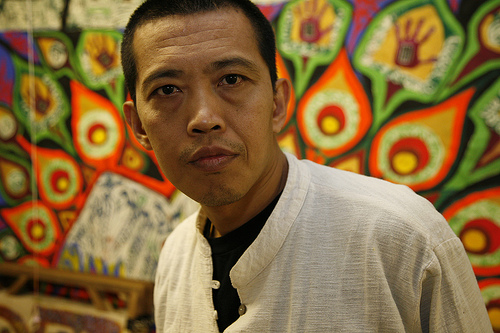Htein Lin: The Master of Prison Art
The life of an imprisoned painter and performance artist

Htein Lin. Photography ©Martin LeSanto-Smith
Last year, I wrote an article about finding lice in the village I grew up in. After reading my essay, my friend Htein Lin wrote an article describing the big, white lice he had when he was arrested in the jungle for being part of a student army. The Burmese political community bristled at this article because it was about the killing of pro-democracy students who retreated into the jungles after the 1988 uprising.

- In Burma if you want to hear about issues the newspapers can’t talk about, you should go to a tea shop. Tea houses were where I used to meet with other activists, writers and artists, as well as where I built friendships. Within tea houses we talked about Burmese writers, literary trends we noticed, and, of course, politics. This online space attempts to emulate the conversations I enjoyed in Rangoon’s tea houses.

- Khet Mar is a journalist, novelist, short story writer, poet, and essayist from Burma. She is the author of one novel, Wild Snowy Night, as well as several collections of short stories, essays and poems. Her work has been translated into English and Japanese, been broadcast on radio, and made into a film. She is a former writer-in-residence at City of Asylum/Pittsburgh.
After the uprising in 1988 Htein Lin fled to the Burma-India border and joined the All Burma Students’ Democratic Front (ABSDF). While he was there, he learned to paint under Mandalay artist Sitt Nyein Aye. In 1990, Htein Lin left the border after the Indian government informed the ABSDF that they could not stay on Indian territory if they carried arms. He then traveled to Kachin, in the northern region of Burma near the Chinese border, to join other revolutionaries.
In 1991, the ABSDF imprisoned and tortured him and 80 other students, accusing them of being informers for the regime. Twenty of his comrades were summarily executed or died as a result of torture on February 12, 1992. Htein Lin escaped to China, but his freedom was short-lived as he was caught by the Burmese military government.
Eventually Htein Lin was able to return to Rangoon University and resume his law studies. He and graduated in 1994. Soon after he was introduced to performance art, which was uncommon in Burma at the time. Because of his performances, he was again arrested and sentenced to 7 years in prison.
While his imprisonment was unfortunate, it also allowed him to start a new life, gaining a foothold in the international art world. He painted in prison, using the white cotton uniforms as canvas. In the absence of brushes, he used his fingers, cigarette lighters, syringes, carved soap, and dinner plates to make his marks. Eventually, these prison art paintings were exhibited in Burma and London.
A few days after his release, Htein Lin came up to my table in a tea house and introduced himself. This simple introduction began a friendship that has lasted eight years. In this time we have become separated geographically, as Hein Lin moved to London in 2006, but our minds have stayed close. The magazine he edits, Kaung Kin (The Sky), is a place to share the experiences of writers who, like me, are living abroad.
We reunited in 2010 when we participated in an art festival in Fort Wayne, Indiana, home to the largest Burmese community in the US. The focus of Hein Lin’s performance was to save the Irrawaddy River by stopping the construction of a large hydroelectric dam that was planned by the Chinese government.
I called him while I was writing this and asked if he wanted me to include any words from him. He explained how he has felt for a long time. To be brief, he is planning a performance that will start presently and end when he dies. It will be interesting to see how this performance will represent Burma and its people.
Translation: Courtney Wittekind





One Comment on "Htein Lin: The Master of Prison Art"
Trackbacks for this post